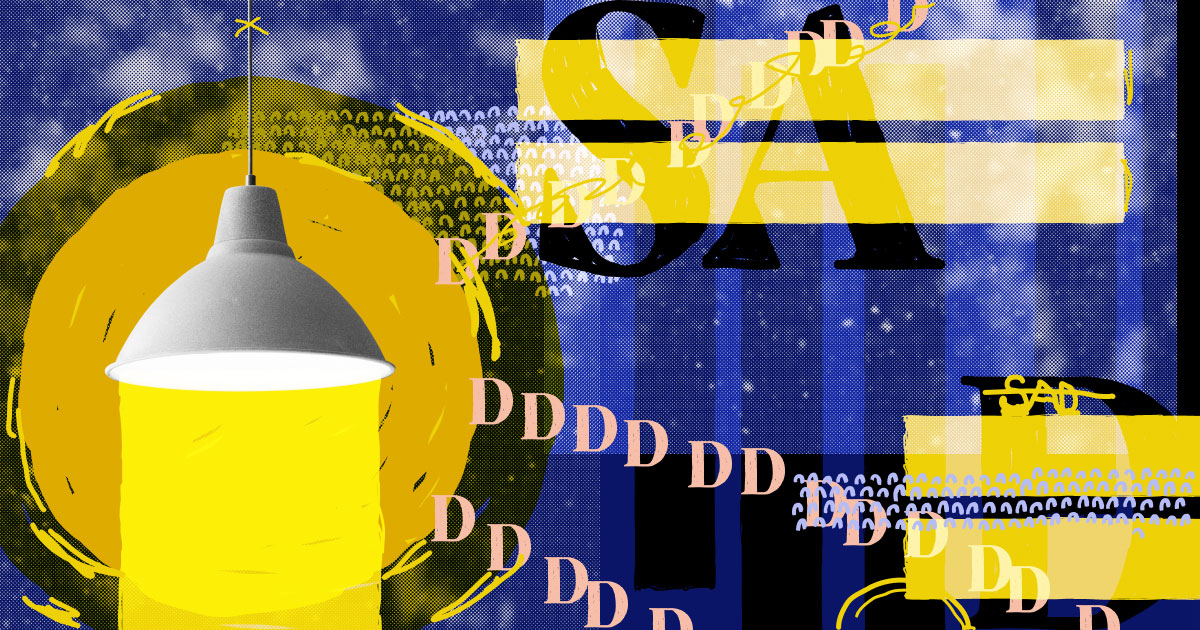Anyone living far enough from the equator can find that the short days and cold weather of the winter season have them feeling gloomy, and tech workers are particularly susceptible to the winter blue and seasonal affective disorder (SAD). If you feel that your good mood has gone with the summer sunshine, you’re not alone, especially if you’re a desk-based worker with little access to outdoor time during the winter season. Decreased exposure to sunlight during the winter months is common for most folks as working hours take up the majority of the shorter daytime hours leading up to and following the winter solstice. Research points to decreased daylight exposure disrupting the body’s internal clock (AKA our circadian rhythm) which can, in turn, impacts the body’s levels of serotonin and melatonin, causing the phenomenon we know as the winter blues, and the more serious medical diagnosis of seasonal affective disorder.
What are the winter blues?
The winter blues are a mild case of negative seasonal mood changes and are often linked to a certain event, like the slump after holiday time off work spending time with loved ones. The winter blues are a milder condition than SAD and are not classified as a discrete medical condition, therefore it can be harder to understand just how many people are impacted by the condition. However, Everyday Health estimates that between 10 and 20 per cent of Americans experience seasonal mood changes.
What are the symptoms of the winter blues?
Those suffering from the winter blues will likely have less energy than usual but still be able to complete their daily tasks like work, school, and household responsibilities. The winter blues are characterized by feeling down, experiencing a lack of energy, and feeling less interested in activities that a person usually enjoys. These decreased moods are typically temporary and last less than two weeks, although those living in especially dark, cold climates may experience them for longer.
What is seasonal affective disorder?
Seasonal affective disorder, also sometimes referred to as seasonal depression, is a well-defined and more severe medical disorder that is a subtype of depression. Everyday Health reports that between one and nine per cent of Americans are diagnosed with SAD.
Seasonal affective disorder follows a regular pattern, meaning it appears around the same time every year. There are both summer and winter variations of SAD, but most people are familiar with winter SAD, which usually begins when the days are shortening. The condition will typically resolve after several months during the spring with longer daylight hours. SAD is also more common for those who live in northern regions where the daylight hours are even shorter. News in Health reports that in Florida only about one per cent of the population suffers from SAD, whereas Alaskans in the northernmost region of the US are impacted at greater rates of about 10 per cent. North of the border, it’s estimated that about two to six per cent of Canadians are diagnosed with SAD, according to the National Library of Medicine.
What are the symptoms of SAD?
SAD is marked by typical symptoms of depression like sadness, lack of motivation, problems sleeping and concentrating, and increased irritability. Folks suffering from SAD may experience changes in their diet and weight gain due to increased cravings for carbohydrates, which is linked to the depletion of serotonin in the brain. Carbohydrate-rich foods can spike the amount of serotonin in your body, which is why you may find yourself reaching for sweet foods and snacks when you’re feeling down or stressed.
Who is affected by the winter blues and SAD?
The winter blues and SAD can affect anyone, but according to the Mayo Clinic, there are several characteristics prevalent in those most at risk of developing the winter blues or SAD.
- Women (SAD is four times more prevalent in women, according to the National Library of Medicine)
- Younger adults (diagnoses are most typical between the ages of 18 and 30)
- People already diagnosed with other forms of depression or bipolar disorder
- People with a family history of SAD, depression, or other mental disorders
- People who live far from the equator and have less access to daylight hours
- People with low levels of vitamin D
Related: Expectations vs. reality on what it’s really like working in tech with a disability.
.jpg)
Is SAD the same as the winter blues?
While the winter blues and SAD follow similar patterns in that they both appear as the days shorter and will go away naturally during the spring or summer, they are not the same. “SAD is a more complex disorder that is not just sadness. People with SAD exhibit signs of a major depressive disorder,” Georgia Gaveras, Chief Psychiatrist and Co-founder of Talkiatry, tells Very Well Mind. In short, SAD is a medical diagnosis, while the winter blues are not. Some people can manage their changes in mood with some lifestyle changes, however, for more serious cases where symptoms continue for longer than two weeks, it is always recommended to seek medical advice from a doctor or mental health professional.
How can you tell winter blues and SAD apart?
The winter blues and SAD can be differentiated by their severity, duration, and the affected individual's ability to function regularly.
- Severity: Symptoms of the winter blues are milder, while symptoms of SAD mimic those of other types of severe depression including hopelessness, despair, and fatigue. SAD can lead to more serious symptoms like self-medicating, self-harm, and suicidal thoughts.
- Duration: The winter blues typically last a few weeks, while those suffering from SAD are typically impacted from the winter solstice to spring, for as many as five months.
- Ability to function regularly: While the winter blues may impact your energy levels and enjoyment of day-to-day life, SAD can impact a person’s ability to complete daily activities, like your job or housework.
Here’s how the winter blues and seasonal affective disorder impact tech workers
Tech workers may be particularly susceptible to the winter blues and SAD due to their office and computer-based work, which can keep them out of what little sunlight there is during a winter day. Consider your routine in the wintertime and how your work hours and office space may impact the amount and quality of sunlight you receive.
- Do you work near a window where you can get a good amount of natural light throughout the day?
- If you work in an office, do you arrive before the sun has risen and leave after it has set?
- Do you live in a location that’s frequently overcast, rainy, or snowy during the winter, limiting the amount of sunshine you see throughout the day?
- Do you work from home and not get outside until your workday is complete after the sun has already set?
- Do you take frequent breaks during the day to get outside and move your body?
For the tech community, working environments and hours can often limit the amount of exposure to sunlight, particularly in the winter. If you’re noticing signs of the winter blues and SAD, read on for the most effective ways to counter them.
Related: 7 tips to avoid screen fatigue and preserve your productivity.
.jpg)
How to counter the winter blues and seasonal affective disorder
Treatments for the winter blues and SAD can be similar, but if you believe you’re suffering from SAD, always seek the advice of a medical professional or mental health professional. They may recommend following a common treatment plan. Since SAD and the winter blues follow a predictable schedule, try to start these treatments early in the winter months each year, along with other preventative measures like regular exercise, a varied and mindful diet, taking time off from work and social media, and calling on a support system when needed.
Light therapy
Interestingly, in Sweden where the days are extremely short in the winter months, some bus stops have been converted into UV light therapy boxes to help civilians treat SAD (Pfizer). To treat SAD or the winter blues, it’s recommended to get outdoors for 30 minutes on a sunny day and up to two hours on a cloudy day (Mayo Clinic). The reality is that many of us do not have that time during the daytime hours when most folks are working. Light therapy is an alternative treatment that is shown to be highly effective in treating both the winter blues and SAD. According to News in Health, studies show that light therapy can relieve SAD symptoms by 70 per cent after a few weeks of treatment. However, “a sizable proportion of patients improve but do not fully respond to light therapy alone.” To be effective, light therapy should continue daily until the spring months. Dawn simulators (think sunrise alarm clocks) are another alternative that can help with feeling sluggish on those dark mornings.
Therapy
Cognitive behavioral therapy (CBT) is a type of talk therapy that is commonly used to treat SAD. News in Health explains that working with a talk therapist and identifying negative thoughts can reframe them to be less negative, or even positive. The National Library of Medicine shared research that two 90-minute sessions of CBT therapy per week were equivalent to a half hour of 10,000 lux light therapy each day. In less severe cases, self-counseling and meditation were also found to be effective in preventing and treating the winter blues.
Vitamin D supplements
Many people experiencing the winter blues or SAD are deficient in vitamin D. Vitamin D helps boost serotonin levels and when the body isn’t producing as much naturally through exposure to sunlight, it can be supplemented by taking daily vitamin supplements. Research from the NLOM study suggests that taking doses of 100,000 IU of vitamin D daily may improve symptoms. Chat with your doctor before starting any supplements.
Hang in there, spring is on its way.









.jpg)

